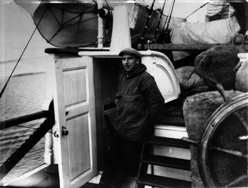 Wolfgang R. Jacoby* celebrates the centenary of the greatest revolution in Earth science since James Hutton.
Wolfgang R. Jacoby* celebrates the centenary of the greatest revolution in Earth science since James Hutton.
Geoscientist 22.09 October 2012
One hundred years ago, in the German city of Frankfurt, a young man who at Marburg University worked as a physicist and meteorologist told a meeting of the recently founded Geologische Vereinigung (GV) how the Earth functions. He shocked the meeting of eminent geologists with an outrageous idea – that since the Late Palaeozoic the continents and oceans were not fixed - and that they had once been grouped together in one vast supercontinent, Pangaea, and one even larger ocean. The continent had fragmented and the fragments drifted apart, five modern oceans forming between them.
Caption: Alfred Wegener on board of the ship "Godhaab", before crossing Greenland in 1912/13, Photo: Alfred Wegener Institute
Alfred Wegener and his ideas were not welcomed and his ideas were rejected furiously by most geologists. However, he was convinced that his unorthodox interpretation explained a wealth of many puzzling observations better than other theories - and in a manner that definitely called for further tests. In the same year, 1912, his ideas were published in an important geographical journal, Peterman’s Geographische Mitteilungen (PGM). Geographers seemed less hostile to his ideas, which Emile Argand (University of Lausanne) and an early convert, later referred to as ‘mobilism’.
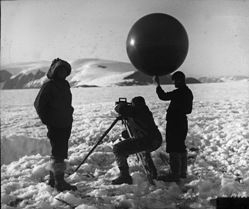 Caption : Wegener launching a meteorological balloon. Photo: Alfred-Wegener-Institut
Caption : Wegener launching a meteorological balloon. Photo: Alfred-Wegener-Institut
Early in the 20th Century, Earth science was making great strides. Was there a general unifying theory, such as cooling and shrinking, that could embrace all the new discoveries? Influential geologist Eduard Suess suggested that contraction caused episodic sagging of the Earth’s surface, as former continents foundered. But many thought that continents and oceans were permanent. Little was known about the seafloor then, and the concept of geological time was vague and relative. Lord Kelvin’s estimate of the Earth’s cooling time provided millions of years, but uniformitarianism, combined with estimates of the rates of various processes, seemed to demand much longer than that and certainly more than the paltry millennia of biblical creation. Palaeontologists envisaged ‘infinite’ epochs of evolution. Radioactivity had been discovered, but was not yet convincingly applied to absolute dating. Earth evolution was the subject of many speculative ‘geotectonic hypotheses’.
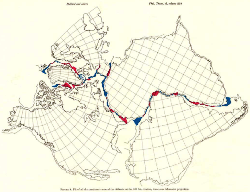 MATCH
MATCH
Wegener had not hitherto been involved in the debate - surely an advantage - but he was probably aware of it. This was in his character; although focused on meteorology and the study of the atmosphere, he was curious about the Earth as a whole and often looked at globes and wondered about patterns of land and sea. His fiancée, Else Köppen, in her 1960 biography of Alfred, quotes from a letter of January 1911: “My roommate … got Andree’s Handatlas (Scobel, 1910) as a Christmas gift. For hours we admired the magnificent maps. A thought occurred to me: … Does not the east coast of South America fit the west coast of Africa as though they had been contiguous in the past? Even better is the fit seen on the bathymetric map of the Atlantic when comparing … the break-off into the deep sea. I must follow this up”. So we can date the spark that led to Wegener’s revolutionary mobilist ideas precisely to Christmas1910.
Caption: The Bullard Fit – from ‘The Fit of the Continents Around the Atlantic’, co-authored by Sir Edward Bullard, 1965 (Royal Society)
Others had noted the match – Bacon, 1620; Osmond Fisher, 1889; George Darwin, 1898; William Pickering, 1907; Frank Taylor, 1910; Alexander von Humboldt, 1801. Wegener was not then aware of them, and none of them had thought of continental drift in quite the way he had. In 1910, Taylor attempted to explain Mesozoic to Recent orogeny on a global scale by suggesting large changes in planetary oblateness. Wegener remarked: “It does not appear that Taylor has realised the immense consequences of such large displacements of continents. As he did not investigate the implications despite their contradiction of traditional views, his suggestion has probably been met mostly with scepticism. For my work this was not the starting point … I learnt about it later.”
Wegener began to look in earnest for evidence in the geological literature (not in those days the huge flood it is today!). It was then that he came across earlier allusions to the fit of coastlines, and the palaeontological literature on ‘land bridges’.
He was alert to Theodor Arldt’s 1907 book: Die Entwicklung derKontinente und ihrer Lebenswelt [The evolution of continents and their living beings], an analysis of what some 20 palaeontologists had to say about trends in the evolution of species on landmasses now facing one another across wide oceans. Between Africa and Brazil, for example, he found that divergence began in late Early-Cretaceous, providing strong support for their former contiguity. On the basis of Arldt’s analysis, in 1921 he plotted the evidence for both convergence and divergence against stratigraphic time to illustrate initial contact and later separation of continents.
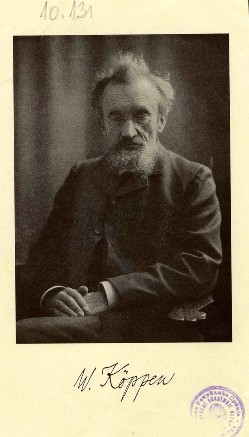 CONNECTION
CONNECTION
Another persuasive argument was the connection of geological structures, such as coal-bearing Carboniferous formations, across oceans like the Atlantic. He clearly saw the climatic argument provided by evidence of Permian glaciation on continents now far distant from one another. By reassembling continents Wegener found that a wealth of geological and geophysical phenomena fell into place, which increasingly convinced him that continental drift was a reality.
Caption: Wladimir Peter Köppen (1846-1940), Climatologist and Wegener’s father-in-law.
And so, as we mentioned above, on 6 January 1912, at a meeting of the Geologische Vereinigung (GV) in Frankfurt, he went public for the first time, with a lecture entitled Die Herausbildung der Großformen der Erdrinde (Kontinente und Ozeane) auf geophysikalischer Grundlage [Building Earth’s main crustal structures (continents and oceans) on a geophysical basis]. This was later published in GV’s journal, Geologische Rundschau. We have noted that geological audience’s negative reaction; but a few days later, speaking on ‘Horizontal Drift of the Continents’ to the Marburg Society for the Advancement of Science, he enjoyed a more positive reception and immediately afterwards began work on the extended version ‘PGM12’, which he finished in a few months. Six months later he boarded a ship for Greenland and Iceland.
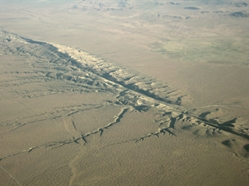 COLLEAGUES
COLLEAGUES
Wegener’s Marburg colleagues helped greatly by searching the literature and bringing him references: “The geologists recover everything I need and bring it to me, saving nine tenths of my time. Otherwise it would have taken months…”. Young geology professor Hans Cloos remained sceptical but constructive, and Wegener updated his paper with new results and arguments.
Caption: Dragon's Back (Elkhorn Scarp) in the Carrizo Plain – the trace of the San Andreas Fault.
Wegener wrote: “Such a large number of surprising simplifications and interrelationships become visible after only a preliminary scanning of the main geological and geophysical results, and for that reason alone I consider it justified, even necessary, to replace the old hypothesis of sunken continents by the new one, because it appears to be more successful. The old hypothesis [land bridges] has been demonstrated inadequate by its antithesis of the permanence of the oceans. In spite of its broad foundation I call the new idea a working hypothesis and I wish it to be taken as such, at least until it has been possible to prove by astronomical positioning with undoubtable accuracy that the horizontal displacements continue to the present day.”
 So what made Wegener so sure he was on the right track? Else Wegener quotes from a letter he wrote in 1911 to her father Vladimir Köppen, who had advised his young protégé against allowing himself to be ‘side-tracked’. Wegener responded: “I think you consider my original continent [Pangaea] more fantastic than it is, and you do not see that it is but an interpretation of observations. … We must assume a land connection, e.g., between South America and Africa, which ended at a certain time. It may have happened in two ways: (1) by the collapse of a connecting continent or (2) by the widening of a great rift. … The first one contradicts the modern concept of isostasy and our physical understanding. A continent cannot sink, for it is lighter than that on what it floats. Considering the second hypothesis, we find a wealth of simplifications making more sense in the whole geological history; should we not throw the old hypothesis overboard?”
So what made Wegener so sure he was on the right track? Else Wegener quotes from a letter he wrote in 1911 to her father Vladimir Köppen, who had advised his young protégé against allowing himself to be ‘side-tracked’. Wegener responded: “I think you consider my original continent [Pangaea] more fantastic than it is, and you do not see that it is but an interpretation of observations. … We must assume a land connection, e.g., between South America and Africa, which ended at a certain time. It may have happened in two ways: (1) by the collapse of a connecting continent or (2) by the widening of a great rift. … The first one contradicts the modern concept of isostasy and our physical understanding. A continent cannot sink, for it is lighter than that on what it floats. Considering the second hypothesis, we find a wealth of simplifications making more sense in the whole geological history; should we not throw the old hypothesis overboard?”
Caption: The Alfred Wegener Institute of Polar and Marine Research in Bremerhaven, Germany. Building near the Old Port in the city. Photo: Alfred Wegener Institute
In the early decades of the 20th Century geographical research was closer to geology than it is today and geographers were less inhibited by geotectonic doctrines. The editor of PGM, Professor Langhans, accepted Wegener’s manuscript for publication unabridged, in three parts. The article caused great excitement, and not all of it negative. Its arguments ought to have made objective geologists think; but first reactions were inevitably rather subjective. Many renowned geologists ridiculed the idea.
Strong opposition from geologists and (especially) geophysicists persisted for decades worldwide, especially in Germany and America, even into the 1960s. In contrast, several geodesists, especially the director of the Geodetic Institute Potsdam, Friedrich Robert Helmert, considered drift a serious hypothesis. Unfortunately, in the 1930s geodetic observations were too inaccurate for adequate tests to be conducted. By the time I was a student, in the late 60s, the tide was turning; but most of my teachers were still very sceptical.
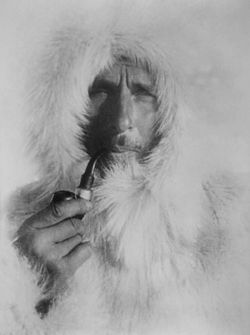 PALAEOCLIMATE
PALAEOCLIMATE
After World War I, Alfred Wegener worked in Hamburg; he and Else were married and moved in with her parents. Close cooperation developed between Wegener and his father-in-law. Else wrote that her father first opposed the new ideas but as he became more involved became convinced that the idea provided ‘paths through the labyrinth of palaeoclimates’.
Else wrote: “Often my father waited impatiently for Alfred to come home and to discuss new arguments”. Wegener himself wrote of how he enjoyed: “...a daily exchange of ideas with Köppen, and I had the satisfaction that he, initially cool and doubtful, increasingly warmed to drift theory, and finally convinced himself that here the ‘red thread’ through the labyrinth of palaeoclimatology had been found. Several chapters were written in such close exchange of ideas that the bounds of intellectual ownership can no longer be decided”.
Four years of criticisms, support and hard work resulted in their book Die Klimate der geologischen Vorzeit [The climates of the geological past] (1924). One positive voice came from Milutin Milankovitch, who wrote: "I am impressed by your splendid concise and concentrated presentation. I am easily convinced by such a material of facts woven into a common idea.”
Wegener thought a lot about the mechanism of drift. However, his priority in ‘PGM12’ was to describe the phenomenon. Explanations could wait. After discussing isostasy and plasticity at length and describing geosynclines in a quite modern way (as an isostatic response to sediment loading of continental margins) Wegener wrote: “…what forces cause horizontal drift, is an obvious question … but premature. It is first … necessary to exactly realise the reality and nature of the movements before we can hope to understand their causes.” He discussed polar wander, and thought of it as a consequence, not a cause, of mass-changing redistribution related to drift. He considered tidal forces a more likely cause. “Possibly for the time being, it is best to consider continental drift the consequence of accidental currents inside Earth. Hopefully it will be possible in the future to separate the accidental aspects from the tendency toward equilibrium in rotation.”
Interestingly, at first Wegener envisioned a phenomenon akin to ‘seafloor spreading’. In ‘PGM12’ this idea is expressed twice, most significantly on page 305: “… we now seem able to explain the different ocean depths.
Since for large areas we will have to assume isostatic compensation of the seafloor, the difference means that the seafloor we believe to be old is also denser than that believed to be young. Moreover, it seems undeniable that freshly exposed sima … will for a long time maintain … higher temperatures (perhaps 100°C in the uppermost 100km on average) than old, largely cooled seafloor. … The depth variation appears also to suggest that the Mid-Atlantic Ridge should be regarded as the zone in which the floor of the Atlantic, as it keeps spreading, is continuously tearing open and making space for fresh, relatively fluid and hot sima from depth.”
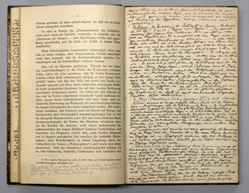 WORLD WAR ONE
WORLD WAR ONE
Wegener was woulded early in the war, and it was while convalescing in Marburg that he wrote the first version of his 1915 classic text Die Entstehung der Kontinente und Ozeane [The Origin of Continents and Oceans], in which he replaced his earlier ‘sea-floor spreading’ idea with a model involving continental ‘rafts’ floating through viscous sima. Why did he do this? Perhaps it was an arctic explorer’s experience of ice as a flowing, solid ‘rock’.
Image : Alfred Wegener's copy of the first edition of ‘Die Entstehung der Kontinente und Ozeane’, filled with his handwritten notes, Photo: Claudia Pichler, Alfred Wegener Institute
Three more editions followed, the second (1920) written mostly in Marburg, the third (1922) in Hamburg, and the fourth in Graz (1929). The subject of seafloor spreading was never taken up again. In parts his formulations became somewhat defensive, but although the driving mechanism still went unexplained, his conviction remained unshaken that the ‘mobilist’ view of Earth better explained Earth history and structure than fixist hypotheses could. In the fourth edition, Wegener wrote: “Relative continental movements have been determined by purely empirical means. … So were the planetary movements of free fall. Then came Newton and derived the laws of gravitation. … The Newton of continental drift has not yet appeared.”
He discussed mantle convection as a possible driving mechanism, but wrote cautiously: “If the theoretical foundations prove reliable … , which is not yet clear, convection will have to be taken into account as an agent shaping Earth’s surface.” Summarising: “It must be taken for sure: the forces which move the continents are the same as those that form the great fold mountain belts. Continental drift, divergence and convergence, earthquakes, volcanism, transgressions and polar wander are interconnected in a grand causative scheme. … Which is cause and which effect, the future will show.” At much the same time, Arthur Holmes (1928) proposed the existence of mantle convection resulting from radiogenic heat. In his revised edition of Principles of Physical Geology (1965), Holmes treated many aspects of the present essay.
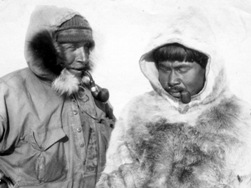 DEATH ON THE ICE
DEATH ON THE ICE
Wegener did not live to see his last edition in print. He was away in Greenland, where he died in 1930 - shortly after his 50th birthday, returning from the central station on the ice-cap to the western main station. He had intended to bring desperately needed supplies and had to return on skis with only the one Greenlander, Rasmus Villumsen - who buried him in his tent dug into ice, marking the grave by his skis. Their radio did not work. The following spring, a search party found the grave. Wegener probably died of heart failure. Rasmus had taken his diaries - but himself never reached the west station. His body was never recovered.
Image: One of the last, if not the last pictures: Wegener with Rasmus Villumsen, whose body was never found.
So what prepared Wegener to become the researcher who, a century ago, introduced continental drift as a general theme in Earth history, explaining in such an engaging manner a much wider variety of terrestrial phenomena than any previous theory had done, and who, over the following decades, inspired others to go out and test his ideas? We read of his very early interest in nature, encouraged by his parents - especially his mother. His father was religious, but not dogmatic. Alfred and his brothers and sisters were allowed great freedom. There were arguments between son and father; but in the end, Alfred followed his own interests - which broadened as he grew older. Skilled at seeing connections, he was able to formulate ideas that explained them lucidly. On a global basis he assiduously collected observations and, after reviewing them critically, boldly accepted their consequences. He became courageous and was unafraid of debate and argument.
All these things are probably significant; but in the end we must take Wegener as the true ‘Newton of continental drift’ – the man who made mobilists of us all.
Acknowledgements
I owe the opportunity to write this essay to the Editor of Geoscientist and his Editorial Board. Ted Irving contributed insights into palaeoclimatology in untangling continental drift and polar wander, and the cooperation between Köppen and Wegener. I thank him for reviewing my draft, many clarifying comments and corrections. Exchange with numerous colleagues over the years has helped me better understand Wegener the man, and his science. Finally, I am grateful to Alfred Wegener himself for the inspiration and encouragement that his life and work have given me.
* Wolfgang Jakoby is Professor Emeritus of Geophysics at the University of Mainz, Germany.
Further reading
- Arldt, T: “Die Entwicklung der Kontinente und ihrer Lebenswelt” Engelmann, Leipzig, 729 pp, 1907 (reprint: publ ‘Let me print’, 744 pp , ISBN 5-87458 437 4, 2012
- Bacon, F: 1620: Novum Organum, Leiden, Adrian Wyngaerden, 1620
- Darwin, G H: The tides and kindred phenomena in the solar system Houghton, Boston, 1898
- Fisher, O: Physics of the Earth’s crust , Larden, McMillan, 391pp 1889 (185r/2) 185e/9)
- Holmes, A: "Radioactivity and Earth movements" Transactions of the Geological Society of Glasgow, 18, 559-606, 1928
- Holmes, A: Principles of Physical Geology, 2nd ed , Nelson, London, 1965
- Humboldt, A v & Bonpland, A: Reise in die Aequinoctial-Gegenden des Neuen Continents Vol 6, Lightning Source UK Ltd (paperback, 2011) 1801
- Jacoby, W R: Modern concepts of earth dynamics anticipated by Alfred Wegener in 1912 Geology, 9, 25-27, 1981
- Köppen, V , Wegener, A: Die Klimate der geologischen Vorzeit Borntraeger, Berlin, 255 pp , 1924
- Newman, R P: American Intransigence: The Rejection of Continental Drift in the Great Debates of the 1920's Earth Science History, 14:1, 1995
- Oreskes, N: The Rejection of Continental Drift: Theory and Method in American Earth Science, Oxford University Press, 1999 (ISBN 0-19-511733-6)
- Pickering, W H: The Place of Origin of the Moon – The Volcanic Problems In: Popular Astronomy, 15, 274-287, 1907
- Scobel, A (editor): Andrees Allgemeiner Handatlas, 5th ed , Velhagen & Klasing 1910
- Taylor, F B: Bearing of the Tertiary mountain belt in the origin of the earth’s plan Geol Soc Am Bull , 21, 179-226, 1910
- Wegener, A: Die Entstehung der Kontinente Petermanns Geograph Mitt , 58 I, 185-195, 253-256, 305-309, 1912a
- Wegener, A: Die Entstehung der Kontinente Geol Rundschau, 3, 276-292, 1912b
- Wegener, A: Die Entstehung der Kontinente und Ozeane Vieweg, 94 pp (Slg Wissenschaft 23) , 1915
- Wegener, A: Die Entstehung der Kontinente und Ozeane 2nd ed , Vieweg: 135 pp (Slg Wissenschaft 66) 1920
- Wegener, A: Die Theorie der Kontinentalverschiebungen Zeitschrift der Gesellschaft für Erdkunde zu Berlin Nr 3/4, 89-103, 1921
- Wegener, A: Die Entstehung der Kontinente und Ozeane 3rd , Vieweg: 144 pp (Slg Wissenschaft 66) 1922
- Wegener, A: Die Entstehung der Kontinente und Ozeane 4th ed , Vieweg: 231 pp (Slg Wissenschaft 66), 1929
- Wegener, E: Alfred Wegener Tagebücher, Briefe, Erinnerungen Brockhaus, 262 pp 1960
Arldt, T: “Die Entwicklung der Kontinente und ihrer Lebenswelt” Engelmann, Leipzig, 729 pp, 1907 (reprint: publ ‘Let me print’, 744 pp , ISBN 5-87458 437 4, 2012